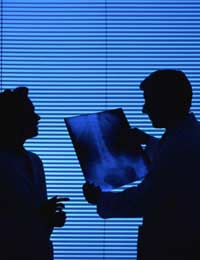The Spine: Skeletal Components

Far from being the longest bone in the human body, the spine is made up of 33 oddly shaped bones called vertebrae which allow for a strong and flexible column. It is not just the bony matter that makes up the spine, there are many other components including intervertebral discs, facet joints muscles, ligaments, tendons, nerves, the spinal canal and of course the spinal cord.
Regions of the Spine
There are 5 separate areas of the spine, each with its own characteristics and functions, these are the cervical spine (comprised of 7 vertebrae), the thoracic spine (made up of 12 vertebrae), the lumbar spine (5 vertebrae), the sacral spine (5 fused vertebrae) and the coccyx (4 fused vertebrae).The spine has four natural curves, two are called lordotic, and the other two are called kyphotic.
The Cervical Spine
The cervical spine begins at the base of the skull and individual vertebrae become larger the further down the spine they appear. Physicians usually abbreviate vertebrae by using the initial letter of the region and their corresponding sequential number, for example C1 down to C7.Unlike the rest of the spine, the cervical spine contains a small opening for the passage of blood vessels, carrying blood away from the heart allowing it entry to the brain.
The cervical spine is responsible for the movement of our head and neck, with the first two vertebra, the atlas and the axis, being designed entirely for the rotational movement of the head.
The Thoracic Spine
The thoracic spine is found in the chest region of the body and supports the ribs which protect our major organs.The thoracic vertebrae increase in size as they descend down the spinal column, and are not all alike, as some thoracic vertebrae have unique physical characteristics. For example T1 and T9-T12 each possess peculiarities that serve an independent function.The most prominent part of the kyphotic curve of the thoracic spine is found at T7.
The thoracic spine also has a small degree of lateral curvature and physicians cannot agree why this is so. Many believe it is an anatomical feature, while others believe it depends on which side carries the individual’s dominant dependence. There is evidence to support both of these theories.
The Lumbar Spine
Though the lumbar spine is commonly reported to have 5 vertebrae, it is not unusual to find people who posses 6.The lordotic curve of the lumbar spine is more apparent in women than men, and is more marked at the lower end of the region.The lumbar spine is responsible for bending, twisting and turning, and provides the strength to enable us to lift, thus making it a very vulnerable area and prone to injury.
The true spinal cord ends at L1 where it divides into many nerve roots that extend to the lower body and legs. This collection of roots is called the ‘cauda equina’.
The Sacral Spine
The sacral spine contains 5 fused vertebrae and supports the posterior region of the pelvis. There are marked differences in the shape of the sacral vertebrae between men and women, with women having a shorter and wider version than that of males. Each person’s sacrum has a differing degree of curvature, though in males, the curvature tends to be less and more evenly distributed.The Coccyx
Situated at the bottom of the spine, the coccyx, is made up of between 3 and 5 fused vertebra, and is a left-over evolutionary factor that other vertebrates have to support their tail.It has a triangular appearance, and size is unique between individuals. Different to other vertebrae, the coccyx is made of solid bone.


Re: Who is at Risk of Developmental Back Pain?
I have been getting muscle spasms in my lower back for 30 years and when they occur I walk like an old man. I…
Re: A Spinal Tap Caused My Back Pain
When I was 14 I was sent to the emergency room with an illness the doctors couldn't identify. Extremely high fever and high…
Re: A Spinal Tap Caused My Back Pain
I've had spinal meningitis 7 times now. So much scar tissue they have to do x ray with the lumbar puncture. I am having a lot…
Re: A Spinal Tap Caused My Back Pain
Hello I had spinal tap done bout 8 month ago due to a brain aneurysm. I tell you someday they way my back is make me not…
Re: A Spinal Tap Caused My Back Pain
So about 7 or 8 months ago I got a spiral tap preformed due to have being diagnosed with Idiopathic intracranial…
Re: A Spinal Tap Caused My Back Pain
So about 7 or 8 months ago I got a spiral tap preformed due to have being diagnosed with Idiopathic intracranial…
Re: Dehydrated Discs
hI THERE, I have Dyhydration L3/l4 and ll4/l5 and disprotrusion and sequestrated discu after MRI i am aged 52. I had hip pain all night for 3…
Re: A Spinal Tap Caused My Back Pain
Hi . I also had a spinal Tap to check the stages of a bleeiding in my brain. This has caused me serious back pain almost…
Re: Dehydrated Discs
Alex - Your Question:I am a 27 yr old male who up until last year was working 84-108 hrs/week and always had back problems but all the doctors I…
Re: Dehydrated Discs
I am a 27 yr old male who up until last year was working 84-108 hrs/week and always had back problems but all the doctors i had seen told me its…